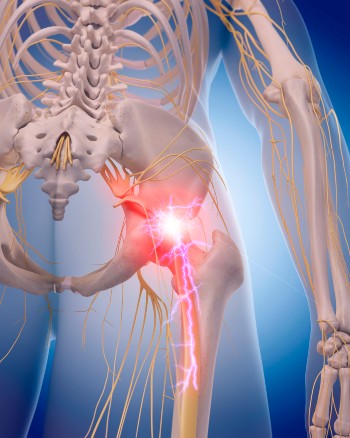
Causes of Sciatic Nerve Pain
Sciatica occurs when the sciatic nerve is irritated, inflamed, compressed or pinched. It is often caused by a herniated disc in the spine or from problems with the hips or pelvis. The pain begins in the lower back and radiates down the leg.
We often use the term “sciatica” to refer to any type of pain that originates in the low back or hip and radiates down the leg. However, true sciatica refers to a problem specifically with the sciatic nerve, which is relatively rare. Sciatica should not be confused with lumbosacral radiculopathy, which is a painful condition that occurs when nerve roots coming out of the lower back are pinched.
Sciatica Symptoms
The symptoms of sciatica can range from infrequent and irritating to severe and debilitating. Usually, sciatica affects only one leg at a time. The pain or discomfort radiates from the lower back or buttock, to the thigh and down the leg. Sciatica may cause pain in the front, back, and/or sides of the thigh and leg.
Sciatica symptoms sometimes do not pinpoint the exact location of the problem area. Combinations of symptoms may suggest different diagnoses, making it difficult to determine where the pain is originating. Conducting online research based on your symptoms is unlikely to give accurate information; instead, you should consult your physician for a clinical evaluation and medical diagnosis.
Common Sciatica Symptoms
Pain
Sciatica pain may be constant or intermittent. It can range from mild to excruciating. The pain is usually described as either a burning sensation or a sharp, shooting pain that radiates from the lower back, to the hip/buttock, and down the leg. In most cases, only one side of the body is affected.
Although the pain originates in the lower back, sciatica is often more painful in the leg than in the back. Leg pain most commonly occurs in the calf region, below the knee.
Certain postures may affect sciatica pain. Changing postures may either aggravate or relieve the pain.
- Sciatica pain may feel worse while sitting, trying to stand up, standing for a long time, bending the spine forward, twisting the spine, and/or while coughing.
- Pain may increase while lying down, which can cause disturbed sleep. Lying on the back with the knees slightly elevated and propped up with a pillow, or lying on the side with a pillow between the legs may help relieve pain while sleeping.
- Pain may be relieved by walking, applying a heat pack to the rear-pelvic area, or by doing pelvic exercises.
Altered sensation
Numbness can occur in the lower back, buttock, leg or foot. A tingling or pins-and-needles sensation may be felt at the back of the leg or in the foot. It is possible to experience an altered sensation in one area and pain in another.
Weakness
Muscle or limb weakness may be felt in the leg or foot. A feeling of heaviness in the affected leg may make it difficult to lift the foot off the floor.
Sciatic Nerve Pain Diagnosis
Your physician will want to distinguish between true sciatic nerve damage and other causes of hip or low-back pain. Other conditions that may have symptoms similar to sciatica include:
- Lumbosacral radiculopathy (pinched nerve roots coming out of the low back)
- Sacroiliac joint (a joint near the low back) arthritis
- Hip arthritis or bursitis
- Various muscle strains in the hamstrings or buttocks
- Piriformis syndrome, which may or may not involve the sciatic nerve
A diagnosis of the underlying cause of sciatica is essential to creating an effective treatment plan and managing sciatica pain. When sciatica is suspected, the physician will take a medical history and conduct a physical examination.
Medical imaging tests, including MRI, are helpful to look for pinched nerve roots in the low back, and diagnostic nerve blocks may be appropriate in some cases. However, these images are not always helpful because many people have bulging discs and other abnormalities that do not cause problems.
Electromyography (EMG) and nerve conduction studies (NCS) are tests used to measure muscle and nerve function. These diagnostic tests can help the physician confirm the diagnosis.
Treatment Options for Sciatica
Sciatica should be treated as early as possible to prevent symptoms from worsening. The pain can usually be treated with non-surgical methods, although surgery may be indicated when there is a severe or progressive neurological deficit such as leg weakness. Surgery is rarely used for damage to the sciatic nerve, but may be more useful when the pain is caused by a pinched nerve root in the back.
The most common treatment is physical therapy and non-steroidal anti-inflammatory medications (NSAIDs) such as ibuprofen or naproxen. Muscle relaxants may be used for temporary relief. Steroid injections may also be used, usually in an effort to get the patient through additional physical therapy.
Contact Us
Please fill out the fields below, and we will contact you.